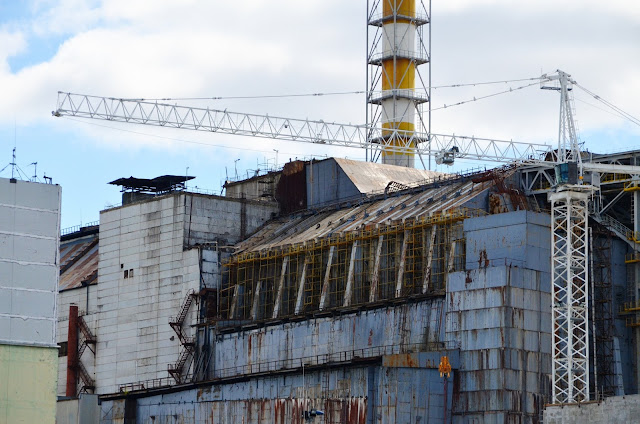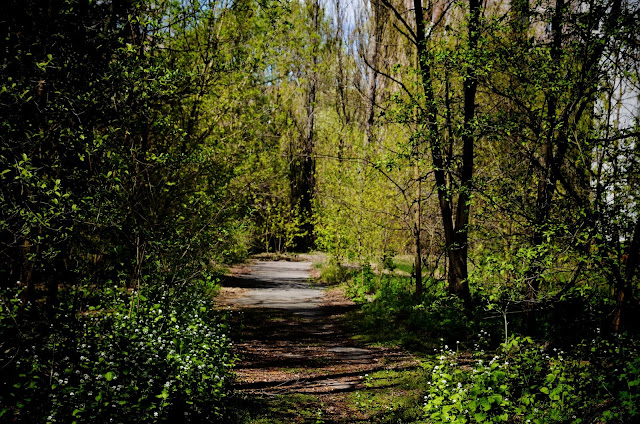Where I try not to glow while I walk through a ghost town in Ukraine on R&R
It's a chilly morning as we pile into the white charter bus that will drive us the 2 hour, 84 mile drive from Kiev to Chernobyl.
 |
| Fried donut hot dog. Because. |
Our meeting point is just across from the maidan, where protests and demonstrations over government corruption climaxed in Russia backed President Yanukovych fled the country. At 7 in the morning, two years later, the plaza is filled with early morning working groups, a number of coffee vendors, and some early risers out walking the streets with jackets pulled in tight from the brisk morning cold.
Maidan
Our tour guide, a young Ukrainian man with sparse fuzz on his chin hinting at his youth double checks our passports, matching our faces and names to a list the company submitted beforehand. Looking at my blue American passport, he flips to the bio page and then glances up at me.
"We don't get as many American tourists since the war," he offers. I ask him where majority of the curious members of my collective were from. "Europe mostly...the UK...even Belarus." Do local Ukrainians come to view this strange containment zone?
"Some. But for most, Chernobyl was a very bad time in their lives. People heard stories, know people. It's a scary place for them, a scary time in history. They don't want to come." He didn't add that the tours were a hefty cost - $160 for my day trip, just under the average monthly income of of 1400 UAH for an average Ukrainian. The In Kiev, the capital city, that average rises to $314. The hryvnia has sharply dropped from 8 to $1 to 25 to one U.S. dollar since 2014.
The drive in is unremarkable - fields, grass, trees like much of the rest of eastern Europe. We spend much of the time watching documentaries about the Chernobyl disaster. April 26, 1986 the Soviet Union was running safety tests on the fourth reactor in norther Ukraine. A spike in temperature during the test by over 3,000 degrees evaporated all the water cooling the uranium in the core. The steam that resulted caused an explosion that blasted around 10 tons of radioactive material out of the no longer existing roof. As the Soviet Union struggled to come to terms with what is considered the greatest man made disaster ever, the invisible radioactive material floated out, triggering alarms at nuclear plants across the rest of Europe. Some later scientific research estimated that the material was carried by wind and elements to nearly 40% of Europe.
At the 30km exclusion zone, we make our first checkpoint stop. We all get off the bus and the military personnel check out passports. Our guide takes this break to answer some more questions including the dangers of radiation on this trip. Lethal radiation poisoning happens at about 300-500 roentgens per an hour. The total radiation for this trip would be in the micros, less than if we took a 10 hour transatlantic flight due to radiation from outer space (something I do quite often...) Nonetheless, we still are asked to sign waivers for liability. Just in case?
The most dangerous areas now in Chernobyl were mainly restricted to the interiors of the sarcophagus, the name of the makeshift cover of the ruined reactor. We stopped to see the reactor for ourselves, a giant massive thing, clean looking with a blue sky background, no the least bit terrifying in just image. One has to imagine the 10 day fire that would not die out after the explosion and picture the air force planes that flew above the deadly heat, sweat covered soldiers throwing bags of sand in by hand to try to dampen the flames.
Reactor 4
The new sarcophagus, a 1.5 billion euro project funded by donations from over 40 countries sits just a short distance away, waiting for when it would be slid over the old one, hopefully keeping things safely confined for another 100 years. (Does anyone else feel that's a bit too short?)
See the massive silver dome? That's the new sarcophagus, the New Safe Containment.
Other than the dogs by the bridge and fish (I didn't see any of the incredibly large fish although something was clearly snatching the floating potato chips out of the water) we didn't see much of the wildlife. However Chernobyl has now become the near equivalent of a wildlife reserve with many animals flourishing in the uninhabited areas. And they may have it for some time to come. The estimates are that due to the natural decay of radiation, the area will not be safe for human habitation for another 20,000 years.
The road turns past some trees and sad looking radiation warning signs. The streets have all been repaved to help cut down on radiation contamination, but the dirt and wildlife is another matter.
We pull over to the side of some derelict buildings in Kopachi, a kindergarten hidden behind an overgrown yard. I can just make out some broken windows, so filthy with dust and dirt, you can't make out anything inside. The grass outside has grown up past the toys lying here and there. A sun bleached toy truck sits on top of a post. What appears to be a see-saw bench sits in the distance.
Dusty outdated books. Molding children's clothes. A plastic doll that hasn't been touch by a child in 30 years, sits alone on top of a bunk, the cushions rotten or destroyed. An abandoned chalkboard sits bare in a corner, the wooden floor rotting and forming a pit that is slowly claiming the ground around it.
Prypyat, a once up and coming town was created to house the family of the reactor personnel. Less than 2 miles from the reactors, it's a short drive up past overgrown grass fields and the faded wooden welcome sign. The night the explosion occurred, the town had a population of over 43,000. The evacuation orders finally came 36 hours after the explosion - the citizens give a few hours to leave on buses and told they would be back in a few weeks, their homes and lives left in the town.
"In the next few years, the towns around the area were mostly all evacuated and the people told to move because it wasn't save. The land wasn't safe for food, the area wasn't safe. My family was evacuated in the early 1990's and we moved to a small city closer to Kiev." Our tour guide pointed out memorial placards marking all the towns emptied out by the disaster.
We pick our way through a supermarket, climbing stairs and rubble, using cellphones to light the way through dark rooms and corridors. I wondered if I fell and scrapped something, should I be worried first about tetanus or radiation?
The tv documentary on the bus showed a clip of Mikhail Gorbachev looking very sympathetic. He called Chernobyl perhaps the real cause of the fall of the Soviet Union. Simplistic considering the complexities surrounding the Soviet Union at that time, but it was only 6 years after Chernobyl that the Soviet Union collapsed.
"Chernobyl. This is the Soviet Union's gift to us, a gift that keeps on giving," our guide joked as we rounded yet another once classic soviet decorated street, drawing our attention to the famous Soviet seal on the hotel in a distance.
A walk through more overgrown paths ("Try not to touch the plants or kick the dirt," he warned, "There are higher radiation levels in vegetation and the dust. And do not eat anything, even if it looks good.") led us through a football field. Or rather, the remnants of a football stand. Built for the local football team Stroitel ("Builders." The soviets were very dependable with their naming conventions.) one can no longer pick out where the old football field used to be unless you look at photos.
Perhaps one of the most famous pictures from Chernobyl is of the abandoned ferris wheel. A brand new amusement park, meant to be opened for the upcoming May day celebration, it sits now a yellow relic, rickety rusted seats hanging in the air.
Broken window panes let the setting sun stream in on an abandoned indoor gymnasium. Basketball hoops. A waterless pool, the clock still ready to go on the wall. A single pommel horse in a room, covered with dust.
I climb three stories of the brick and cement middle school number 3 (one of 5, yet another example of Soviet naming). Old school gas masks are strewn under our feet like a rubbery art display at some exhibit at the MOMA, supposedly pilfered by later looters for the minute silver contained in the filter. Propaganda on the great Lenin hangs on the wall along with school desks flopped over pathetically on their sides. Hundreds on hundreds of school books lay scattered by classroom doors.
On the third floor, water damage is more apparent. The sound of dripping water follow me as I wander alone down past darkened doorways, splashing little pools of calcium deposits (I hope) here and there on the ground.
I wonder where are these children now.
(Yes, this is what I do when invited to take R&R. Which is when the Department pays for my ticket while I'm posted at certain posts to a relaxing place like say, Sydney, but I have the option to cost construct and go off exploring abandoned radioactive ghost towns and say hi to my A-100 colleagues instead. Still my own leave though.)
Soviet Union Duga Radar "Woodpecker"
























































































Comments
Post a Comment